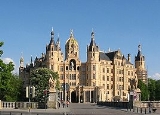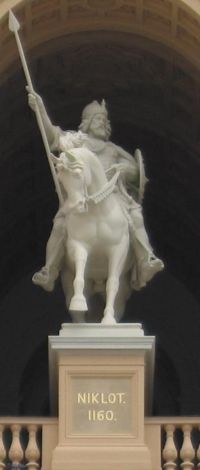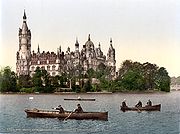
Schwerin Castle
Encyclopedia

Castle
A castle is a type of fortified structure built in Europe and the Middle East during the Middle Ages by European nobility. Scholars debate the scope of the word castle, but usually consider it to be the private fortified residence of a lord or noble...
located in the city of Schwerin
Schwerin
Schwerin is the capital and second-largest city of the northern German state of Mecklenburg-Vorpommern. The population, as of end of 2009, was 95,041.-History:...
, the capital of the Bundesland of Mecklenburg-Vorpommern, Germany
Germany
Germany , officially the Federal Republic of Germany , is a federal parliamentary republic in Europe. The country consists of 16 states while the capital and largest city is Berlin. Germany covers an area of 357,021 km2 and has a largely temperate seasonal climate...
. For centuries it was the home of the dukes and grand dukes of Mecklenburg
Mecklenburg
Mecklenburg is a historical region in northern Germany comprising the western and larger part of the federal-state Mecklenburg-Vorpommern...
and later Mecklenburg-Schwerin
Mecklenburg-Schwerin
Mecklenburg-Schwerin was a duchy in northern Germany created in 1348, when Albert II of Mecklenburg and his younger brother John were raised to Dukes of Mecklenburg by King Charles IV...
. It currently serves as the seat of the state parliament.
History

10th century
First reports of a castle on the location were made in 973. There was a fort of the Polabian SlavPolabian Slavs
Polabian Slavs - is a collective term applied to a number of Lechites tribes who lived along the Elbe river, between the Baltic Sea to the north, the Saale and the Limes Saxoniae to the west, the Ore Mountains and the Western Sudetes to the south, and Poland to the east. They have also been known...
tribe of the Obotrites
Obotrites
The Obotrites , also commonly known as the Obodrites, Abotrites, or Abodrites, were a confederation of medieval West Slavic tribes within the territory of modern Mecklenburg and Holstein in northern Germany . For decades they were allies of Charlemagne in his wars against Germanic Saxons and Slavic...
on an island in the large Lake of Schwerin
Schwerin
Schwerin is the capital and second-largest city of the northern German state of Mecklenburg-Vorpommern. The population, as of end of 2009, was 95,041.-History:...
.
12th century
In 1160, the fort became a target of GermanicGermanic Christianity
The Germanic people underwent gradual Christianization in the course of Late Antiquity and the Early Middle Ages. By the 8th century, England and the Frankish Empire were Christian, and by AD 1100 Germanic paganism had also ceased to have political influence in Scandinavia.-History:In the 4th...
noblemen planning to expand their territory eastward under the leadership of Henry the Lion
Henry the Lion
Henry the Lion was a member of the Welf dynasty and Duke of Saxony, as Henry III, from 1142, and Duke of Bavaria, as Henry XII, from 1156, which duchies he held until 1180....
(1129–1195). The Obotrites under Niklot
Niklot
Niklot or Nyklot was a pagan chief or prince of the Slavic Obotrites and an ancestor of the House of Mecklenburg. From 1130 or 1131 until his death he was chief of the Obotrite confederacy, the Kissini, and the Circipani. At the same time he was Lord of Schwerin, Quetzin, and Malchow...
destroyed the fort but left because of the Germanic military dominance.
However, the German conquerors recognised the strategic and aesthetically interesting location of the island and started building a new fort. The foundation of the city of Schwerin
Schwerin
Schwerin is the capital and second-largest city of the northern German state of Mecklenburg-Vorpommern. The population, as of end of 2009, was 95,041.-History:...
took place in the same year. Schwerin became seat of a bishopric.
In 1167, Henry gave the County of Schwerin to his vassal Gunzelin von Hagen, and the rest of the country around the city was returned to Niklot's son Pribislav
Pribislav of Mecklenburg
Pribislav was an Obotrite prince and the first Prince of Mecklenburg .Pribislav was one of three sons of the Obotrite chieftain Niklot, who was killed in 1160 during a joint campaign by Duke Henry the Lion of Saxony and King Valdemar the Great of Denmark...
, forming a ducal hereditary line that lasted until 1918.
14th century
In 1358, the County of Schwerin was bought by the descendants of Niklot, who had been elevated to Dukes of Mecklenburg in 1348. Soon, they relocated farther inland from MikelenburgMecklenburg Castle
Mecklenburg Castle was a medieval castle and a residential capital of the Nakonid and Nikloting dynasties of the Obotrites. It was located just south of the modern village Dorf Mecklenburg, seven kilometres south of the Bay of Wismar in Mecklenburg-Vorpommern, Germany. The only remnants of the...
, near the city of Wismar
Wismar
Wismar , is a small port and Hanseatic League town in northern Germany on the Baltic Sea, in the state of Mecklenburg-Vorpommern,about 45 km due east of Lübeck, and 30 km due north of Schwerin. Its natural harbour, located in the Bay of Wismar is well-protected by a promontory. The...
, to Schwerin. During the late Gothic
Gothic architecture
Gothic architecture is a style of architecture that flourished during the high and late medieval period. It evolved from Romanesque architecture and was succeeded by Renaissance architecture....
era, the growing prosperity and position of the dukes lead to a growing need for a representative castle, and this meant architectural changes to the fortress settlement. The Bishop's House (German Bischofshaus) from that period remains intact.
16th century

Renaissance
The Renaissance was a cultural movement that spanned roughly the 14th to the 17th century, beginning in Italy in the Late Middle Ages and later spreading to the rest of Europe. The term is also used more loosely to refer to the historical era, but since the changes of the Renaissance were not...
was dominant in North German architecture, and Schwerin's terracotta was supplied from Lübeck
Lübeck
The Hanseatic City of Lübeck is the second-largest city in Schleswig-Holstein, in northern Germany, and one of the major ports of Germany. It was for several centuries the "capital" of the Hanseatic League and, because of its Brick Gothic architectural heritage, is listed by UNESCO as a World...
.
A few years after reworking the castle itself, from 1560 to 1563, Johann Albrecht rebuilt the castle's chapel. It became the first new Protestant church of the state. The architecture was inspired by churches in Torgau
Torgau
Torgau is a town on the banks of the Elbe in northwestern Saxony, Germany. It is the capital of the district Nordsachsen.Outside Germany, the town is most well known as the place where during the Second World War, United States Army forces coming from the west met with forces of the Soviet Union...
and Dresden
Dresden
Dresden is the capital city of the Free State of Saxony in Germany. It is situated in a valley on the River Elbe, near the Czech border. The Dresden conurbation is part of the Saxon Triangle metropolitan area....
. The Venetian Renaissance gate, its gable showing the carrying of the cross, was made by Hans Walther (1526–1600), a sculptor from Dresden
Dresden
Dresden is the capital city of the Free State of Saxony in Germany. It is situated in a valley on the River Elbe, near the Czech border. The Dresden conurbation is part of the Saxon Triangle metropolitan area....
. Windows on the northern face show biblical illustrations by well-known Dutch artist Willem van den Broecke (called "Paludanus") (1530–1580).
As the castle needed additional defences, despite its island site, some time in the middle of the 16th century bastions were established to the north-west, south-west and south-east. They were probably built by the same Italian architects who, under Francesco a Bornau, also worked in Dömitz
Dömitz
Dömitz is a municipality in the Ludwigslust-Parchim district, in Mecklenburg-Western Pomerania, Germany. It is situated on the right bank of the Elbe, 25 km southwest of Ludwigslust, and 37 km northwest of Wittenberge....
. The bastions were later modified several times, but they are still standing today.
17th & 18th century

Thirty Years' War
The Thirty Years' War was fought primarily in what is now Germany, and at various points involved most countries in Europe. It was one of the most destructive conflicts in European history....
, the architect Ghert Evert Piloot, who had entered Mecklenburg's service in 1612, made plans to completely rebuild the castle in the style of the Dutch Renaissance. In 1617, work began under his supervision, but soon had to cease due to the war. Piloot's plans were later partially put into practice between 1635 and 1643: the house above the castle kitchen and that above the chapel were razed and given Dutch Renaissance style façades.
During this period, a half-timbered building was constructed near the chapel to house the archducal collection of paintings. Also, the Teepavillon (tea house) was built.
The court moved to Schloss Ludwigslust
Schloss Ludwigslust
Schloss Ludwigslust is a castle in Mecklenburg-Vorpommern, northern Germany. It was built as a hunting lodge, rebuilt as a luxurious retreat from the ducal capital, Schwerin, then became for a time the center of government...
in 1756.
19th century

Schwerin
Schwerin is the capital and second-largest city of the northern German state of Mecklenburg-Vorpommern. The population, as of end of 2009, was 95,041.-History:...
, but the building was in relatively bad condition. Additionally, the Grand Duke didn't like the individual buildings' incongruent origins and architectural styles.
Grand Duke Friedrich (1800–1842) decided to rebuild the castle, and ordered his architect Georg Adolph Demmler (1804–1886) to do so. A few months later, construction was halted by his successor, Friedrich Franz II (1823–1883), who wanted a complete reconstruction of the historic site. Only some parts of the building from the 16th and 17th century were kept.
Dresden architect Gottfried Semper
Gottfried Semper
Gottfried Semper was a German architect, art critic, and professor of architecture, who designed and built the Semper Opera House in Dresden between 1838 and 1841. In 1849 he took part in the May Uprising in Dresden and was put on the government's wanted list. Semper fled first to Zürich and later...
(1803–1879) and Berlin architect Friedrich August Stüler
Friedrich August Stüler
Friedrich August Stüler was an influential Prussian architect and builder. His masterwork is the Neues Museum in Berlin, as well as the dome of the triumphal arch of the main portal of the Berliner Stadtschloss.-Life:...
(1800–1865) could not convince the grand duke of their plans. Instead, Demmler included elements of both of them into his plan, but would find inspiration in French Renaissance
French Renaissance
French Renaissance is a recent term used to describe a cultural and artistic movement in France from the late 15th century to the early 17th century. It is associated with the pan-European Renaissance that many cultural historians believe originated in northern Italy in the fourteenth century...
castles. It became the most admired master work of the student of Karl Friedrich Schinkel
Karl Friedrich Schinkel
Karl Friedrich Schinkel was a Prussian architect, city planner, and painter who also designed furniture and stage sets. Schinkel was one of the most prominent architects of Germany and designed both neoclassical and neogothic buildings.-Biography:Schinkel was born in Neuruppin, Margraviate of...
. He also planned a government building in 1825-26 located at Schlossstraße (today the State Chancellery).
Renaissance châteaux of the Loire
Loire
Loire is an administrative department in the east-central part of France occupying the River Loire's upper reaches.-History:Loire was created in 1793 when after just 3½ years the young Rhône-et-Loire department was split into two. This was a response to counter-Revolutionary activities in Lyon...
valley such as Chambord
Château de Chambord
The royal Château de Chambord at Chambord, Loir-et-Cher, France is one of the most recognizable châteaux in the world because of its very distinct French Renaissance architecture which blends traditional French medieval forms with classical Renaissance structures.The building, which was never...
) also inspired him and contributed to the construction from 1843 until 1851.
His successor Stüler, again, changed a few things, and included a statue of Niklot on horseback, and the pompous cupola. For the interior design, Heinrich Strack
Heinrich Strack
Johann Heinrich Strack was a German architect of the Schinkelschule. His notable works include the Berlin Victory Column.-Life:...
(1805–1880) from Berlin was chosen. Most of the work was done by craftsmen from Schwerin and Berlin.
20th century
There was a fire in the castle in December 1913. The revolutionRevolution
A revolution is a fundamental change in power or organizational structures that takes place in a relatively short period of time.Aristotle described two types of political revolution:...
in 1918 resulted in the abdication of the Grand Duke, but only the exterior reconstruction had been completed. It later became a museum and in 1948 the seat of parliament. The German Democratic Republic
German Democratic Republic
The German Democratic Republic , informally called East Germany by West Germany and other countries, was a socialist state established in 1949 in the Soviet zone of occupied Germany, including East Berlin of the Allied-occupied capital city...
, opposed to nobility, used it as a college for kindergarten teachers from 1952-1981. Then it was a Museum again until 1993. The Orangerie had been a technical museum since 1961. From 1974 on, some renovated rooms were used as an art museum.
Since late 1990, it is once again a place of government and representation as the seat of the parliament of State of Mecklenburg-Vorpommern. Since then, massive renovation efforts have been conducted and are, due to the complexity of a castle of this size, still in progress.
Ghosts
The small impious ghost PetermännchenPetermännchen
Petermännchen is a small good natured household spirit who is said to live in the Schwerin Castle in Schwerin, Mecklenburg, Germany. The diminutive spirit, maybe only a few feet tall, is often described as carrying many keys, roaming through the vaults and tunnels underneath the castle, unlocking...
reportedly roams the halls of the Schwerin castle. This little spirit is no more than a few feet high, and is often depicted in clothes from the 17th century, something resembling a cavalier. His existence may be in doubt, but he is a popular legend as ever.
External links
- Schwerin Castle – Travel Centre
- Schwerin Castle – Schwerin Tourist
- Schwerin Castle – Tom P. Galvin
- State Parliament of Mecklenburg-Vorpommern (German)

